
* In the late 1940s, the Soviet Union introduced a new aircraft, the Antonov "An-2". It was a big, clumsy looking biplane intended for utility and cropdusting roles, and led to laughs in the West at Soviet backwardness. The An-2 had the last laugh, since it proved an immensely useful aircraft, was built in huge quantities, and is still in intensive service all over the world. This document provides a history and description of the An-2.
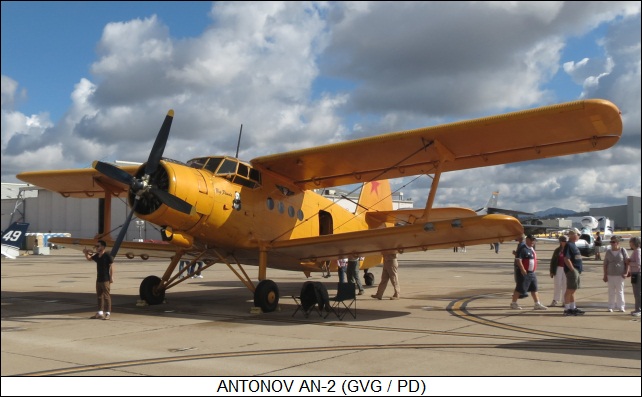
* During World War II, the Soviet Union made extremely good use of the little Polikarpov Po-2 biplane, which was at heart a trainer but was pressed into a wide range of other roles, including liaison aircraft, light attack aircraft, cropduster, and air ambulance. The Po-2 might not have seemed like much, but it did a superb job, and after the war, it would be replaced by a bigger and better successor.
Aircraft designer Oleg Konstantinovich Antonov had started out in the mid-1920s building gliders, becoming the USSR's most prominent glider builder. He spent World War II working as first deputy to Alexander Yakovlev in his aircraft OKB (experimental design bureau). In 1940, before the Nazi invasion of June 1941, Antonov had considered the design of a utility aircraft, using as a conceptual basis the Bedunkovich SKh-1 (Selzkokhozyaistvennyi 1 / Agricultural Economy 1"), a utility biplane with a radial engine and fixed landing gear that never entered series production.
Antonov's original design, designated simply "Aircraft Number 4", was much like a scaled-up SKh-1, but it seemed too old-fashioned and slow, and the authorities rejected the design in 1941. Once war came, Antonov had other things to worry about, but he didn't forget about his biplane design. In 1944, he came forward with a revised big biplane design, which incorporated features from the OKA-38 Aist (Stork) -- a copy of the German Fiesler Fi 156 Storch short take-off and landing (STOL) light utility aircraft. The Soviets had built two Aists during the cynical "friendship of convenience" between the USSR and Nazi Germany, and Antonov had worked on them.
Once again, Antonov's proposal met with little interest, but he really thought that his big STOL utility biplane was something the Soviet Union needed. It would help improve agricultural productivity through crop-dusting, and would be useful for transport in Siberia and other primitive regions of the USSR. With the end of the war in 1945, Yakovlev let Antonov go to the OKB branch facility in Novosibirsk, beyond the Urals in western Siberia, to pursue the utility biplane concept.
The authorities still weren't interested, but in early 1946 Antonov sent a detail design document for the proposed aircraft back to Yakovlev, who passed it up the chain of command along with a note that the aircraft should be built. Yakovlev was highly influential and the authorities finally took notice, authorizing in March 1946 the construction of two prototypes of the "izdeliye (product) T" (for "transportniy / transport") -- though only one prototype would actually be built. At the end of May, Antonov was given authority over his own design bureau, OKB-153.
At the end of July, the project goals were clarified, specifying the izdeliye T as a replacement for the Po-2, tailored to meet the needs of the Soviet Ministry of Agriculture & Forestry. Some sources claim this specification got the project rolling; actually, the project got rolling and led to the specification.
Antonov wanted to use the 750-kW (1,000-HP) Arkady Shvetsov ASh-62IR engine, a nine-cylinder air-cooled radial, but the ASh-62IR was in heavy demand for the Li-2 transport, a Soviet license-built copy of the American Douglas DC-3 / C-47 Dakota. As a result, the authorities wanted him to use the smaller ASh-21 radial with a 520 kW (700 HP), specifying that he build separate prototypes with the different engines. Antonov protested at length, since he felt that the ASh-21 simply wasn't powerful enough to do the job, and that the duplication of effort on prototypes would delay the schedule. The authorities finally caved in, but still insisted that the design be able to use either engine.
By early 1947 a full-scale mockup was ready, with the type having been given the designation of "SKh-1", recycling the designation of the unproduced prewar Bedunkovich machine. The initial prototype was rolled out in the summer of 1947; development had been hastened by use of "off the shelf" components, such as the main wheels from the Ilyushin Il-2 Shturmovik ground-support aircraft and the tailwheel of the Tupolev Tu-2 bomber.
The prototype was fitted with the ASh-21 engine for ground trials, but was then refitted with the ASh-62IR engine for its first flight on 31 August 1947, with test pilot P.N. Volodin at the controls. The ASh-21 engine was refitted during the trials to determine whether it was adequate -- and it obviously wasn't, justifying Antonov's protests. The aircraft itself was clearly sound, with few tweaks required during trials and one test pilot praising its handling by saying that "the machine is stable during turns, easy to fly and a lot like the Po-2. In the event of a forced landing, this aircraft can put down on dirt roads and in small clearings without any risk."
The consensus was that anyone who could fly, could fly the SKh-1. Volodin flew the prototype from Novosibirsk to Moscow in October 1947 for state acceptance trials. The original plan had been to transport it by rail, but the flight was seen as an effective way to promote the aircraft. State trials went well, with flights even made with General Ivan P. Mazuruk, an aviation celebrity for his daring prewar polar flights and holder of the prestigious Hero of the Soviet Union medal. During one flight, General Mazuruk wanted to land at the Moscow-Vnukovo Airport, but was refused landing permission by air traffic controllers. He shrugged and simply put the machine down on the grass runway shoulder. The airport director, a colonel, came out in a fury -- to suddenly become very agreeable, switching immediately from stormclouds to sunshine, when he realized who the pilot was. Rank has its privileges.
* By the summer of 1948, the SKh-1 was in field trials in Ukraine and elsewhere, demonstrating its massive superiority over the little Po-2. However, Antonov still had to deal with threats to his baby. With the Cold War getting chillier, Soviet production of weapon systems was going full steam, leaving little manufacturing capability left over for a more or less civil aircraft. Fortunately, Nikita Sergeyevich Khrushchev, Communist Party general secretary of Ukraine and later Soviet premier, had been impressed by the SKh-1 and encouraged his superiors in Moscow to put it into production.
In August 1948, formal approval of the production of the type was granted, with State Factory Number 473 in Kiev assigned to do the work. The aircraft was given the production designation of "An-2". However, it was still not time for Antonov and his design team to break out the champagne, since Factory 473 was a fairly small plant that hadn't ever built an aircraft before; it was just all that could be spared. Setting up the tooling for building an aircraft was bound to be time-consuming, and production forecasts were definitely on the low side. Antonov sent a team of engineers from Novosibirsk to Kiev to try to keep the project on track.
The first production "An-2T" utility transport performed its initial flight on 6 September 1949, with a pre-production batch of four machines delivered for evaluation in May 1950. Shortly after that, the Antonov OKB was relocated to Kiev. The group had never been more than a small and isolated component of the rest of the Novosibirsk facility, meaning there was nothing to keep the staff there when all the manufacturing was taking place in Kiev.
* Things certainly might have seemed to be on track by that time, but late in 1952 the word came down that An-2 production would have to cease, with the Kiev factory reassigned to the manufacture of fuselages for the new Ilyushin Il-28 jet bomber. Antonov might well have despaired, but in March 1953 Soviet dictator Josef Stalin died of a stroke, with a wide number of changes in the way things were done following. One change, implemented as early as April 1953, was to restore An-2 production to Factory 473. It is a certain interesting commentary on the real world to see the haphazard way things actually get done, even in a supposedly rigidly-planned economy.
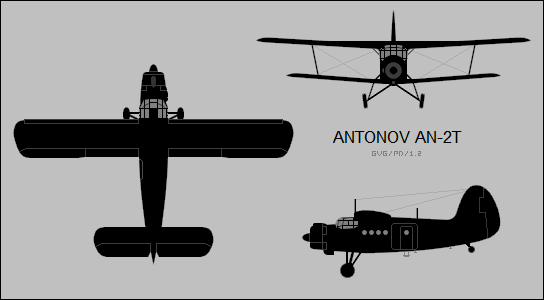
The usefulness of the type was finally appreciated by both the military and Aeroflot, the state airline, with Antonov and his design team receiving a state prize in 1955. Factory 473 would build a total of 3,164 An-2s up to the end of production there in 1963. That was by no means the end of the matter. In 1965, State Factory Number 464 in Dolgoprudniy began production of the modified "An-2M" agricultural variant, building 506 into 1971.
The bulk of production was actually outside of the USSR. In the late 1950s, manufacture of the An-2 was assigned to the PZL Mielec plant in Poland, the initial ten machines being made from knockdown kits provided by the Kiev factory, the first making its maiden flight on 23 October 1963. At first, the Poles were unenthusiastic about building the big, plain biplane, but they soon found out the type was in great demand. Production would continue full bore into the late 1980s, to then start a decline as more modern types were introduced. The last Polish An-2s were delivered in 2002, after manufacture of 11,915 machines from the PZL Mielec plant.
Some sources claim that a small batch of An-2s was built in East Germany, but though the East Germans did modify some of the An-2s provided to them, they never made any themselves. The only other foreign manufacturer of the type was the People's Republic of China, which initiated a project to build the aircraft at a state factory in Nanchang in 1956, the first Chinese-built An-2 performing its initial flight on 7 December 1957. The Chinese originally called the type the "Fongshou 2 (Harvester 2)". Full production began in 1958. Manufacturing was later switched to Harbin and then to Shijiazhuang, with the type redesignated "Yushiji 5 (Y-5 / Transport 5)". The Chinese also found the big biplane very useful and built at least a thousand, with production continuing to the present at a low rate. A drone variant, with more cargo capacity since it didn't have aircrew, was flown in 2023.
* Pilots were said to have fondly called the An-2 the "Annushka", or "Sweet Little Annie", but to everyone else it was the "Kukhuruznik", meaning "corn eater", which was a general term for a crop-duster; the same term was used for the Po-2, but the nickname would become distinctly associated with the An-2. Once the West became familiar with the An-2, it was assigned the NATO reporting name of "Colt", though possibly it might have been more appropriate to name it after the oversized "Clydesdale" dray horse. There was some snickering at the big, homely looking biplane outside of the USSR, since it seemed to reinforce the prejudice that the Soviets were crude and rustic. The reality was that the An-2 would prove to be a superlative aircraft for its intended roles.
It was certainly not regarded as any beauty queen, but it was so useful, sturdy, and docile that few had anything but affection for it. It could take off and land on a postage stamp and was, as mentioned, very easy to fly, though not noted for a blazing rate of climb. It also tended to be tail-heavy; it wasn't wise to place loads too far back in the cargo compartment.
BACK_TO_TOP* The initial production An-2T utility transport version of the An-2 makes a reasonable baseline for description of the family. The An-2T was a fairly big and bulky machine as single-engine piston aircraft go, with a ASh-62IR radial engine, a greenhouse style canopy, biplane wings, and fixed tailwheel landing gear. There were porthole windows on both sides, and an upward-opening cargo door with an inset inward-opening passenger door on the left rear of the aircraft.
Although consideration was given to building the An-2 of steel tubing and fabric, the final decision was to use riveted aircraft aluminum construction with some fabric skinning. The fuselage was all metal; the flight surfaces had aluminum framework, with the two-spar wing skinned with aluminum back to the front spar and covered with fabric elsewhere.
The original tailfin had an elliptical "guitar pick" form factor, but a "squared-off" tailfin was introduced on the An-2M; it was the only major An-2 variant with this feature. The tail surfaces were fabric covered, as were all the flight control surfaces. All flight control surfaces were manually actuated.
___________________________________________________________________
ANTONOV AN-2:
___________________________________________________________________
wingspan (upper):
18.18 meters (59 feet 8 inches)
wingspan (lower):
14.24 meters (46 feet 9 inches)
wing area (total):
71.6 sq_meters (771 sq_feet)
length:
12.74 meters (41 feet 10 inches)
height:
4 meters (13 feet 2 inches)
empty weight:
3,450 kilograms (7,605 pounds)
MTO weight:
5,500 kilograms (12,125 pounds)
max speed at altitude:
260 KPH (160 MPH / 140 KT)
service ceiling:
4,400 meters (14,435 feet)
range (with 500-kilogram / 1,100-pound load):
900 kilometers (560 MI / 485 NMI)
___________________________________________________________________
The Shvetsov ASh-62R engine was a nine-cylinder single-row air-cooled radial, which some sources claim was based on the US Wright Cyclone engine. There was a carburetor intake on top of the engine cowling, an oil cooler below the cowling, and an exhaust on the right side. Kiev-built An-2s used the V-509A four-bladed wooden variable-pitch propeller, with curved blades and a diameter of 3.6 meters (11 feet 10 inches). Most Polish production used the AV-2 four-bladed wooden variable-pitch propeller, with straight, shorter, broader blades and a diameter of 3.35 meters (10 feet 12 inches).
The main landing gear featured pneumatic shock absorbers; agricultural versions had long-stroke shock absorbers to soak up the occasional hit against the ground. The tailwheel castored. Ground steering was by differential braking; the brakes were pneumatic and this was apparently something of a wheezy, comical-sounding process. Skis could be optionally fitted for winter operations.
The cockpit featured dual yoke-type controls, and the extensiveness of the canopy glazing really did give the impression of being a greenhouse, providing excellent visibility in the forward hemisphere. The glazing panels were flat to prevent visual distortion, and the canopy was bulged out to the sides to permit a downward view, a feature referred to as the "balcony" and a handy thing for trying to land on short fields, or during crop-dusting. Avionics included an automatic direction finder, a navigation beacon receiver, a radar altimeter, and radios.
The cockpit was separated from the cargo area by a bulkhead, optionally fitted with a double door. Along with the pilot and copilot, originally a seat could be fitted for a flight engineer, though later production did not require the third crewman. The original cargo door had dimensions of 1.53 by 1.45 meters (60 x 57 inches), but was later expanded to 1.65 x 1.67 meters (65 x 66 inches). There was a fixed step on the bottom of the fuselage under the inset passenger door. The floor was reinforced, and there were tie-downs along the sides of the cargo bay, with screw-in sockets in the floor for inserting more tie-downs.
At first, all An-2s were delivered in overall olive drab coloring. Later, many Aeroflot machines were given snappier civil colors -- light greys or beiges, with blue detailing. With An-2s eventually in wide service all over the world in military, civil, and private hands, some were given wild or outlandish paint jobs -- Japanese animator Miyazaki Hayao sent a bright-red An-2 on a tour of Japan to promote his barnstormer movie epic PORCO ROSSO. One was even, for some bizarre reason, given pre-WWII US Navy colors, including stars with red "meatballs" in the center.
BACK_TO_TOP* Along with the An-2T utility transport, other major An-2 variants included:
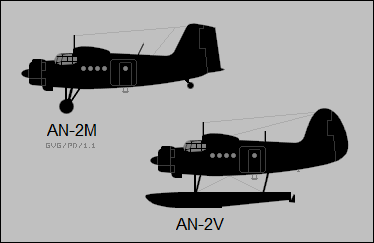
In 1950, the Antonov OKB began work on a floatplane version of the An-2T, which emerged as the "An-4" or "An-2V" (vodniy / water-based). Initial flight was on 31 July 1951. The An-2V also featured waterproofing seals in strategic locations, a power winch, and a reversible propeller. Beaching gear could be used to haul the machine onto dry land. At least one was fitted with crop dusting gear like that of the An-2SKh for forestry purposes. The Poles built this variant under the designations of "An-2M" (morski / marine, duplicating the designation of the improved Soviet cropduster version) or "An-2W" (wodnozsamolot / seaplane).
* Details of Chinese production are a bit unclear, but it appears the An-2T utility transport was built as the "Y-5A"; the An-2SKh agricultural aircraft was built as the "Y-5B"; the An-2TD cargo / paratroop aircraft was built as the "Y-5C"; and the An-2PD executive transport was built as the "Y-5K". Chinese machines were not necessarily perfect equivalents to Soviet machines. In particular, the Y-5C featured modified wingtips with three little finlets sticking out of the end of each tip, the finlets being arranged in tandem but at slightly different angles to the horizontal. The Chinese claimed the finlets improved climb rate and cruise economy.
In 2018, the Chinese also claimed to have flown a Y-5 fitted out as a drone, it appears as an experiment in robotic air resupply. Presumably, the Y-5 was optionally piloted. It doesn't appear there has been any commitment to fielding the scheme yet.
* There were a number of experimental fire-bomber conversions of An-2s, fitted with water or retardant tanks and sprayers. One screwball conversion used a scheme in which the aircraft carried three dispensers containing 120 glass ampoules of retardant each, with the ampoules scattered over the fire area; the concept was found to be ineffective. The only An-2 fire-bombers to see any real use were ten An-2Vs fitted with floats that could store water. These machines were designated "An-2LP" (lesopozharniy / forest fire fighter).
The "An-6" featured a TK-19 turbocharger for improved high-altitude performance and was built in limited numbers. The "An-6 Meteo" or "An-ZA" (zondirovshchik atmosfery / atmospheric sampling) was built for high-altitude atmospheric research, and featured a second heated cockpit forward of the tailfin for a research technician. It did not enter production, the rear cockpit apparently having serious effects on handling -- but six An-6s without the rear cockpit were built for weather studies and designated "An-2V" (vysotniy / high altitude), recycling the floatplane designation.
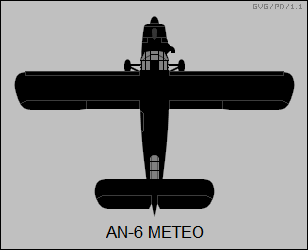
One of the more drastic variations was the "An-2F / Fedya", where "F" was a series code, AKA the "An-2NAK" (nochnoy artilleriskiy korrektirovshchik / night artillery spotter). This was a battlefield observation machine, evaluated in 1948:1950. The entire rear fuselage was replaced with a new rear fuselage, featuring a twin-fin tail, an all-around "greenhouse" center section, and a gun turret on top just behind the wing for top protection, with various armament options tested. It also had a forward-firing cannon, could carry a light bombload, and was fitted with armor. Only two were built, the decision being that helicopters were better suited to the battlefield observation job.
Arguably the most drastic variant of all was the Polish "Lala-1" testbed for the turbofan-powered PZL M-15 agricultural plane. An An-2 was modified by chopping off most of the fuselage aft of the wing; installing an extended tailwheel under the end of the fuselage; fitting a tube frame with a twin-fin tail to the end of the aircraft; and putting the turbofan in the end of the fuselage, with an oversized intake on the right side.
There have been a number of schemes for extensively modifying An-2 to operate as "wing in ground effect (WIG)" or "surface skimmer" craft, with an oversized wing to allow them to efficiently skim over the wavetops at high speed on the cushion of air set up at high speeds. A demonstrator (with wheeled landing gear, not floats), was displayed at the 2003 Moscow Air Show; it was unclear if this was actually a flying machine, or just a mockup.
* A by-no-means complete list of other interesting subvariants and mods includes:
* Formal interest in a turboprop version of the An-2 began in the early 1970s. The Antonov OKB came up with what amounted to an almost completely redesigned follow-on to the An-2 called the "An-3", but on consideration it seemed like overkill, and it wasn't built. Soviet engineering tended toward the pragmatic, generally following the rule of not trying to fix what didn't seem to be really broken. Focus shifted to simply converting the An-2 to a turboprop configuration, with the An-3 designation retained for the conversions.
An An-2SKh was fitted with the Glushenkov TVD-20 turboprop providing 1,065 kW (1,430 EHP), driving a three-bladed reversible propeller. A new door was fitted to the forward fuselage to allow the crew to get in and out when cropdusting gear was installed, eliminating the awkward crew-entry scheme of the An-2M. Cockpit improvements were also provided, particularly an air conditioner, which was something of a necessity during hot summers when the cockpit turned into a sweatbox.
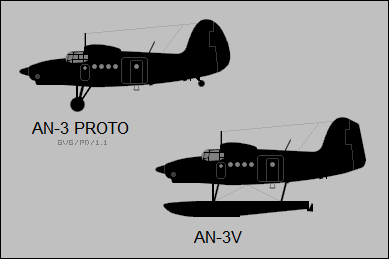
Initial flight was in 1979, but work on the project was protracted, with state trials finally completed in 1991. Various refinements were considered for a "production" An-3, such as a larger squared-off rudder fitted to the existing An-2 tailfin, and simplified window glazing. The plan by that time was to convert most of the An-2 fleet to An-3 standards, but with the fall of the USSR the exercise went on hold.
It appears that the Chinese did fit a number of Y-5s with Pratt & Whitney Canada PT6A turboprop engines, though details are lacking. Work on a turboprop AN-2 has revived in Russia, thanks to the Siberian Aeronautical Research Institute (SibNIA in its Russian acronym). In 2011, SibNIA fitted an An-2 with a Honeywell TPE-331-12 turboprop engine, providing 820 kW (1,100 SHP) and driving a five-bladed Hartzell propeller; modernized navigation kit, plus a diesel auxiliary power unit and cabin heater, were added as well.
The turboprop engine not only promised better performance, but also lower operating costs, kerosene fuel being cheaper than avgas; however, the purchase cost was higher. The updated An-2 was designated "TVS-2MS", with "TVS" standing for "turbo-vintovoy samolyot (turboprop aircraft)", with the machine being publicly introduced at the Moscow MAKS airshow in 2013. It appears that a number of upgrades have been performed by the RusAviaProm firm since then, in the one to two dozen range.
SibNIA then experimentally refitted an An-2 with a new wing made of composite material -- the new wing getting rid of struts and wires, with the lower wing curving up at the tips to mate with the bottom of the upper wing. The "TVS-2-DT" -- the "DT" standing for "demonstrator tekhnologiy" -- made its appearance at MAKS 2015. It was then upstaged at MAKS 2017 with the "TVS-2-DTS" -- the "S" for "serinyi (serial)", meaning "for serial production" -- which added a composite fuselage. It was effectively a completely new aircraft, simply in the general mold of the An-2. According to SibNIA, while the TVS-2-DTS weighed two tonnes more than the An-2, it had twice the speed and lift capacity, plus three times the range. It still retained the short take-off and landing capability of the An-2.
From that time, the story gets muddy. In 2019, after years of considering an An-2 replacement, the Russian Ministry of Industry & Trade issued a requirement for the Lyogkiy Mnogotselevoy Samolyot (LMS / Lightweight Multipurpose Aircraft). The requirement specified:
Take-off / landing characteristics were to be as good or better than that of the An-2. The aircraft was to be powered by a 595 kW (800 SHP) Klimov VK-800S or GE H80-200 turboprop. Concepts were more along the lines of the US Cessna Caravan single-turboprop utility aircraft, not the An-2 -- but Russian society was thrown into a tailspin as a result of the disastrous Russian invasion of Ukraine in 2022, so all plans are in suspension for the time being.
BACK_TO_TOP* The An-2 has seen service all around the world, with An-2s flying now or at one time in all the states of Eastern Europe and China, plus Afghanistan, Angola, Benin, Bolivia, Botswana, Brazil, Cambodia, Chad, Colombia, Cuba, Djibouti, Egypt, Ethiopia, France, Greece, Grenada, Guinea, India, Iraq, Laos, Lesotho, Mali, Mexico, Mongolia, Mozambique, Nepal, the Netherlands, Nicaragua, North Korea, Peru, South Africa, Sudan, Tunisia, Turkey, Venezuela, Vietnam, Yemen, and Zambia. A rising number of An-2s retired from official service have been picked up by private pilots. There are also vague tales of a few An-2s operated by the US Special Operations Command (SOCOM).
An-2s have seen considerable combat action. Soviet forces used them heavily in utility roles at all times, as well as in the role of battlefield spotters during the Hungarian invasion of 1956 and the Afghan War of the 1980s. Apparently some An-2s were used to dump riot gases on Chinese forces during border squabbles in the late 1960s.
The North Vietnamese used the type in their war with the Americans, employing it to haul cargoes, sometimes into South Vietnam, and on occasion as an improvised attack aircraft. US records suggest the An-2 was not well-suited to the strike role, since mentions of encounters with armed An-2s usually state they were shot down. Vietnamese An-2s were used in later conflicts as spotters and utility aircraft. An-2s have been used by North Korea to insert spies and saboteurs into South Korea.
An-2s have played roles in the wars of the Balkan and Soviet successions. Azerbaijan converted dozens of An-2s to drones. During a 2020 border clash with Armenia, the Armenian military released footage of the An-2 drones being shot down. The drones are apparently intended to probe and provoke adversary air defenses.
However, the An-2's major accomplishments have been peaceful, with the type proving an outstanding utility and passenger transport, agricultural aircraft, bush aircraft, and jack-of-all trades. In July 1997, to celebrate the golden anniversary of the An-2, WSK Mielec sponsored a round-the-world flight in an An-2 piloted by Woldemar Miszkurka. It was a leisurely trip, taking three months. Sadly, there was some bureaucratic tangle and the flight itinerary of the commemorative trip did not include Russia.
BACK_TO_TOP* The An-2 wasn't the only small utility transport developed by the Antonov OKB. In 1957, the organization began the design of a twin-engine light cargolifter / transport with a focus on short take-off / rough field operation, easy handling, and simple maintenance. Initial flight of the first of two prototypes was on 15 March 1958. Development was protracted, with the "An-14" finally entering service in 1965. It was named the "Pchelka (Baby Bee)", and also assigned the unflattering NATO reporting name of "Clod".
The An-14 featured a high, wide-span strut-braced wing, with twin Ivchenko AI-14RF nine-cylinder radial piston engines; a twin-fin tail; and fixed tricycle landing gear, with single wheels on all gear assemblies. Each wing featured double slotted flaps and a leading-edge slat, and a brace running from the mainwheel stub wing to midwing. There were clamshell doors on the rear for cargo loading. The aircraft was designed for single-pilot operation; typical payloads included eight passengers, or up to 720 kilograms (1,590 pounds) of cargo.
The An-14 could be fitted with ski or float landing gear, and could be rigged up as a cropduster with a 1,000-liter (264 US gallon) chemical tank. Variants included an air ambulance, with accommodations for six litters and a medical attendant; a dual-control trainer; an executive aircraft, with luxury accommodations for five passengers; and a geophysical photo-survey platform.
___________________________________________________________________
ANTONOV AN-14:
___________________________________________________________________
wingspan:
21.99 meters (72 feet 2 inches)
wing area:
39.72 sq_meters (428 sq_feet)
length:
11.44 meters (37 feet 6 inches)
height:
4.63 meters (15 feet 2 inches)
empty weight:
2,000 kilograms (4,400 pounds)
MTO weight:
3,600 kilograms (7,940 pounds)
max speed at altitude:
220 KPH (140 MPH / 120 KT)
service ceiling:
5,200 meters (17,050 feet)
range (with maximum payload):
650 kilometers (405 MI / 350 NMI)
___________________________________________________________________
The An-14 was not in the same class as the An-2, being smaller, with less payload and range. It was somewhat more comparable to the popular American Beech Model 18, though the two aircraft had very different configurations. The Pchelka was said to be sturdy, but what sort of reputation it had is otherwise unclear. Only about 300 were built to end of production in the mid-1970s -- not a small quantity in itself, but a fraction of An-2 production. The main users were Aeroflot and the Red Air Force. Some were obtained by East Germany, Bulgaria, and Guinea. It may linger in service in small numbers.
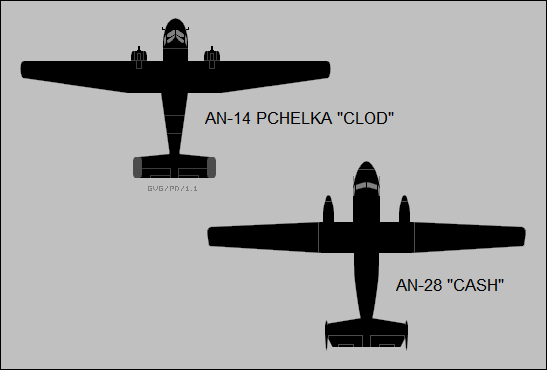
* In 1967, the Soviets announced that a turboprop derivative of the An-14 was in development, with the machine given the original designation of "An-14M". Initial flight of the first prototype was in September 1969, but development of this machine was protracted as well, with the type undergoing major redesign and not introduced into service until 1984 as the "An-28". It was given the NATO reporting name of "Cash".
The overall configuration of the An-28 was like that of the An-14 -- high and wide-span wing, twin tail, fixed tricycle landing gear -- but it was powered by twin Glushenkov TVD-10V turboprops providing 715 kW (960 SHP) each, and featured a fuselage stretch, plus general design cleanup. Cabin volume was doubled and passenger capacity raised to 17; maximum cargo capacity was two tonnes (2.2 tons). The An-28 featured an interesting scheme in which spoilers on one wing were deployed automatically to help with the failure of an engine on the other wing. The cabin included a hoist for cargo handling. Manufacture of the An-28 was farmed out to PZL in Poland; the engines were built in Poland as the "PZL-10S".
___________________________________________________________________
ANTONOV AN-28:
___________________________________________________________________
wingspan:
22.06 meters (72 feet 4 inches)
wing area:
39.72 sq_meters (428 sq_feet)
length:
13.1 meters (43 feet)
height:
4.90 meters (16 feet 1 inch)
empty weight:
3,900 kilograms (8,600 pounds)
MTO weight:
6,500 kilograms (14,330 pounds)
max speed at altitude:
350 KPH (220 MPH / 190 KT)
service ceiling:
6,000 meters (19,685 feet)
range (with 1,000-kilogram / 2,200-pound) payload:
1,365 kilometers (850 MI / 740 NMI)
___________________________________________________________________
The An-28 had a certain broad resemblance to the de Havilland Canada Twin Otter, though the Antonov machine was somewhat bigger and had a twin tail. It appears only a few dozen An-28s were built in Poland before the collapse of the USSR.
PZL Mielec was bought out by United Technologies Corporation, parent company of Sikorsky, in 2007, with Sikorsky bought out by Lockheed Martin in 2015. PZL Mielec retains its identity within Sikorsky / Lockheed Martin. PZL Mielec continues to build the An-28 as the "M28 Skytruck", with 820 kW (1,100 SHP) Pratt & Whitney Canada PT6A-65B turboprops driving five-bladed Hartzell propellers, plus Bendix-King avionics. A stock An-28 was converted as the prototype, performing its initial flight in 1993. M28 configurations include:
PZL Mielec has produced an extremely bewildering range of variants of An-28 / M28 machines, most in small quantities, with Polish armed services using a number of patrol variants.
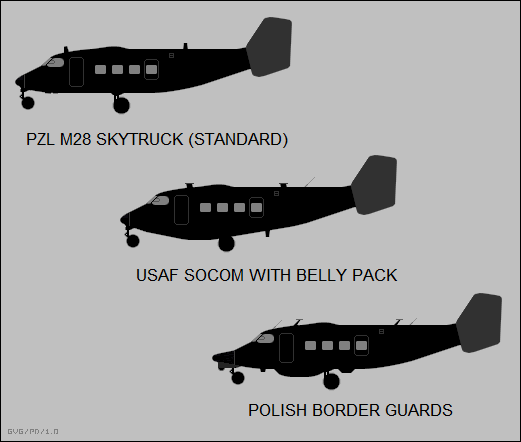
There have also been a number of export orders, with users including Ecuador, Jordan, Nepal, Venezuela, and Vietnam. One particularly interesting export sale was to the US Air Force Special Operations Command (SOCOM), with SOCOM judging the type ideal for relatively light hauling jobs to remote outposts with rough airfields. A total of 16 was obtained from 2010, being designated "C-145A".
The SOCOM machines had a belly pannier in the form of a smoothly curved extension to the aircraft's belly, giving the aircraft a fishlike look. They didn't have winglets, which are sometimes fitted on M28s, but they were kitted up with avionics by a US contractor, no doubt with militarized communications and defensive countermeasures. There was no mention of sensor fits, these machines clearly being assigned to the transport mission.
They didn't remain in service with SOCOM for long, being retired from 2015, with the last withdrawn in 2022 -- it seems because SOCOM was more interested in leasing aircraft from civilian contractors as per mission requirement. Two were transferred to the Arizona Department of Public Safety, while others were transferred to "friendly" nations, including three to Kenya, two each to Costa Rica and Estonia, and a total of five to Nepal.
One Jordanian M28 was updated in the US by Sierra Nevada Corporation to a special-mission standard, with surveillance and intelligence-gathering kit. Sierra Nevada also offered an armed M28, the "MC-145B Coyote" -- featuring four underwing stores pylons and an undernose turret -- for a SOCOM requirement, but didn't win the award.
BACK_TO_TOP* I was reading a book about economic development in Africa written by a reporter, with the author telling a story about a ride in a beer delivery truck in the Cameroons. The trip would have taken less than a day over decent roads, but the roads were in terrible condition and it took three days, with thievish police setting up roadblocks at intervals and confiscating their share of beer for "infractions" of fabricated regulations.
I got to thinking that in such an environment, it might be more cost-effective to use an aircraft. The aircraft wouldn't have to be fast, but it would need to have reasonable range and truck-like cargo capacity. It would also have to be cheap to obtain and operate, extremely sturdy and reliable, and able to fly off of very short rough fields. Then I realized: "It's been done. It's called an An-2."
The An-2 seems to be increasingly a relic these days, but the M28 Skytruck is still going strong. The SOCOM use of the M28 was very surprising -- during the Cold War, nobody would have ever predicted the US military would be operating Soviet aircraft designs -- and it was a bit of a letdown that they were retired from SOCOM.
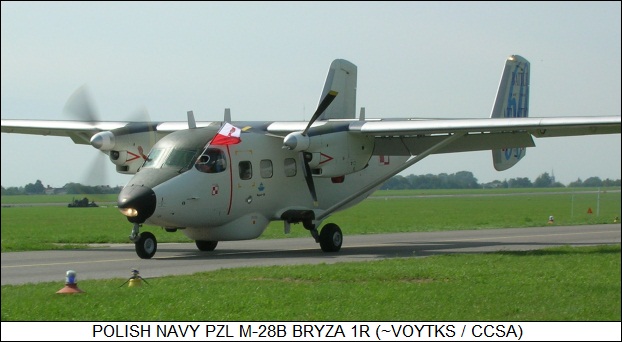
* Sources include:
I was very glad I found the Gordon / Komissarov book on the An-2. Almost all information on Soviet types available in the West before the 1990s, even ones like the An-2 that were not particularly state secrets, is so wildly contradictory as to be completely untrustworthy.
* Revision history:
v1.0.0 / 01 feb 06 v1.0.1 / 01 jan 08 / Review & polish. v1.0.2 / 01 dec 09 / Review & polish. v1.0.3 / 01 nov 11 / Review & polish. v1.0.4 / 01 mar 13 / SOCOM buy of M28s. v1.0.5 / 01 feb 15 / Review & polish. v1.0.6 / 01 jan 17 / Review & polish. v1.0.7 / 01 dec 18 / Review & polish. v1.0.8 / 01 dec 20 / Added LWS. v1.0.9 / 01 oct 22 / Review & polish. v1.1.0 / 01 aug 24 / Review & polish. (+)BACK_TO_TOP
